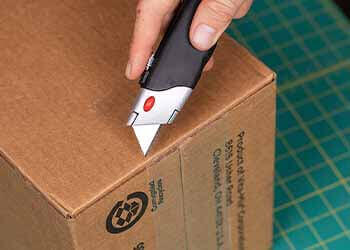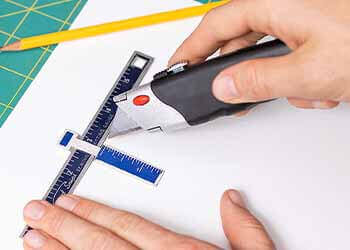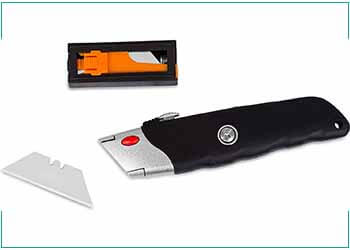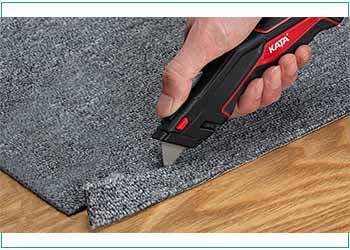Box cutter or utility knife is a very common tool nowadays. These kinds of tools are available in the industry, home, shop, working place, and almost everywhere. Box cutters or utility knives are mostly used in the field of engineering construction, interior decoration, DIY projects, office supplies, and daily life. In this box cutter vs utility knife discussion, we will try to clarify the differences between them. Besides it, choosing the best knife for your EDC (Everyday Carry) is important too. A utility knife is a carpet cutting knife too. Whether a box cutter or a utility knife, you must have to pick the best knife for your job.
EDC (Everyday Carry) is a category of gear that includes essential items such as watches, mobile phones, flashlights, hatchets, knives, and so on. You can call these items bushcraft gear too. Choosing any of the box cutter vs. utility knife would be perfect. But first, you need to know about them.
Contents
Related Articles
Box Cutter Vs Utility Knife
Though the product may be a bit distinguishable the purpose is the same. Cutting different materials easily and faster, box cutters or utility knives are the best tools to cut. If you have knowledge about the Carpet knife vs Utility knife, you can understand the differences of the box cutters vs utility knives topic quickly. So, let’s know more about this.
Box Cutter
What Is a Box Cutter?

A box cutter is a kind of cutting tool that is compact and mainly used to cut boxes. But, truthfully be told, it’s versatile and multi-purpose. A box cutter is good for cutting thinner materials such as plastic film or corrugated packaging. The construction materials between them are the same as well.
According to the Merriam-Webster definition of box cutter, “a small cutting tool that is designed for opening cardboard boxes and typically consists of a retractable razor blade in a thin metal or plastic sheath”.
Box cutters always have less blade exposure than utility knives. Anyways, there are two types of blade control options available for box cutters; manual retraction and auto-retractable.
Features to Look for a Box Cutter
When choosing a box cutter, you must have to focus on some important factors that are unavoidable. A quality box cutter will feature a protective, ergonomic J-hook handle. This J-hook-style handle can make you safe and secure when you work with this blade. As this is a non-slip cutter, it provides you the added benefit of extra comfort and safety.
In addition, a box cutter with as little blade exposure as possible would be very perfect for you. Less exposure doesn’t mean ineffective and useless. Rather it ensures your protection from potential cuts and lacerations.
Switching blades or changing blades is necessary when the blade starts to dull. A dull blade can potentially injure you. So, changing blades when necessary will lessen your risk of injuries. Moreover, your workflow can continue uninterrupted.
Pros of a Box Knife
- Can be made of aluminum alloy or stainless steel
- Blade storage design available
- Safe and secured
- Comfortable handle
- Quick blade change
- Durable and sharp
- Easily portable lightweight
- Ergonomic design
- Humanized design
- Secured blade locking mechanism
- Efficient and easy to handle
- Retractable and adjustable blades
- Replacement blades
- Ideal for heavy duty works
Cons of a Box Knife
- Sometimes a box knife may chip off
- Dull blades need to change frequently
- May rust sometimes
What Are Box Cutters Made Of?
Box cutters can be made of different materials. The most common materials used for making box cutters are:
- High-density molded plastic
- Nylon
- Aluminum die-cast
- Stainless Steel
- TPR (Thermoplastic Rubber)
- Titanium alloy
Different Types of Box Cutters
Box cutters can usually be in different shapes, sizes, colors, and blade sizes. They can be self-retracting or fixed-blade. However, box cutters are easily portable in your pockets and can cut wires, thin cardboard, or plastic wrapping.
Box cutters usually contain only one blade. Larger and heavy-duty box cutters are also available for serious projects. In this case, if the blade becomes dull, you can easily switch the dull one with a new one. It enhances your productivity as well as protects you from injury.
Speaking of an outdoor utility knife, they can be used for various purposes too. However, a utility knife can be used as a substitute tool for a box cutter. Outdoor box cutters are usually fixed, strong and sturdy, and long blades that can often range from 4–6 in length. In addition, these outdoor cutters are tough enough to break easily while working during outdoor activities.
What Are the Sizes of Box Cutters?
Box cutters can be of different sizes which particularly depends on the type of box cutter they are. Sizes of a box cutter available are:
- Mini (finger-sized)
- Small (pen-sized, etc.)
- Large (heavy-duty)
It is worth remembering that the length and width of the box cutters can vary depending on their type, purpose, and any extra features. The very common and usual range of box cutters is from 4 – 8 inches long x 1 -2 inches wide x 0.5 – 2 inches in height.
The mini size is for cutting very simple and soft materials. They are not as tough as small-sized box tools.
The small size box tools are good for cutting materials like paper, rope, rubber hoses, fabrics, and so on.
And the large box cutters are used for heavy-duty purposes such as construction-related jobs, DIY projects, office purposes, for home, and many others.
Box Cutter Weight Ranges
Box cutting knives are generally very small and lightweight enough to carry easily in your pocket. If you specifically want to know the weight ranges of a box cutter, well, the answer would depend on the type of box cutter you purchase.
However, the usual range of box cutters is from 3 ounces to 12 ounces each. In addition, extra materials such as blade storage handles can add extra weight to the box cutter.
Moreover, another strong point is different materials used for box cutting tools can weigh more or less than others because they are not the same in weight. For instance, titanium, aluminum, and nylon weigh less than steel.
Furthermore, the shape, styles, designs, and other features like any holes or cutouts in the material can also affect the weight.
Remember, the less the weight of the box cutter knife, the better to work for a long time it would be.
Utility Knife
What Is a Utility Knife?

A utility knife is a kind of hand-cutting tool that can cut through a myriad of materials. This utility knife is great for industrial, household tasks, DIY projects, office supplies, and many more purposes. A utility knife is like a box cutter tool too.
According to the Merriam-Webster definition, a utility knife is “a cutting tool having a sharp replaceable blade that can be retracted into a usually metal handle”.
Utility knives have thicker handles that are usually made of aluminum, titanium, carbon steel, glass-filled nylon, and stainless steel. In addition, the utility knife blades are constructed with carbon steel, zirconium oxide, and stainless steel.
However, there are three types of blade control options that can usually be seen for utility knives.
Manual retraction – it helps the users to lock the blade in two positions; exposed and retracted.
Auto-retractable – it keeps the blade exposed if the user is holding a slider.
Smart-retracting mechanism – it retracts itself when the edge loses contact with its cutting material.
To be truthful, utility knives are safe due to these options.
Features to Look for a Utility Knife
A utility knife is a versatile and multipurpose knife. From hunting to box cutting, a utility knife is a useful tool. Like a box cutter, you should consider some particular features. A safe and effective utility knife is always preferable.
A quality utility knife for multitasks is made of carbon steel, zirconium oxide, and stainless steel. If the knife is constructed with zirconium oxide, it would be great and last much longer than traditional steel. This element doesn’t let rust on the knife. In addition, a utility knife made of zirconium oxide is gentler on fingers than usual steel.
A durable handle for any knife is recommended. In this blog of box cutter vs utility knife, the utility knife has a long-lasting handle. Anyways, glass-filled nylon is a perfect choice. If the handle of a knife is not comfortable and handy, it can potentially lead to injuries such as repetitive strain injuries (RSI) that cause pain and damage. For your kind information, RSI affects the muscles, tendons, nerves, and ligaments, primarily in the upper and lower arms.
Pros of a Utility Knife
- A heavy-duty knife
- Versatile and multipurpose
- Strong and sturdy
- Retractable and perfectly adjustable
- Lightweight and easily portable
- High strength razor blades
- Quick release system
- Blade locking mechanism
- Replaceable blades
- Blade chamber at handle
- Ergonomic and comfortable handle
- Shock-absorbing and vented pistol grip
- Thumb press for maximum cutting power
- Push-button blade swap for rapid reloading
Cons of a Utility Knife
- Sometimes release mechanism locks persistently
- Blades might not sit properly
- Sometimes hard to use new knives
Now we will try to discuss some related topics of box cutter vs utility knife. This will help to clear the confusion. Then let’s do that.
What Are Utility Knives Used For?
Being a multifunctional cutting tool, a utility knife can be used for various purposes. Utility knives can cut wide lists of materials. These tools are used in engineering construction sectors for daily life tasks.
However, a utility knife is a favorite to a plumber, electrician, home builder, office manager, DIY project manager, and so more others.
In addition, a utility knife is widely used in interior decorations, office supplies, home use, art craft, constructing sites, and so many fields.
What Can a Utility Knife Cut?
If you ask what kind of materials can a utility cut? Well, in that case, a utility knife can cut carpet, paper, rope, rubber hoses, PVC, leather, fabric, Sheetrock, foam, thin metal, meat, bone, tape, plastic, cardboard, and so much more.
Some Box Cutters and Utility Knives You May Like –
Box Cutter Vs Utility Knife: Which One Is the Best for Everyday Carry?

In this box cutter vs utility knife discussion, we have already learned enough to identify the differences between them. This topic could be utility knife vs box cutter too because they are the same as well. Now let’s talk about which one of the box cutters and utility knife is the best for EDC (Everyday Carry).
A box cutter is no big different than a utility knife because they serve common purposes for the users. In some cases, box cutters are only used for cutting boxes, ropes, plastics, papers, and soft materials like these while a utility knife is better for all kinds of cutting jobs. Box cutters are specially designed to cut boxes or other materials like this and this is why a box cutter is the best and most comfortable to cut things like these.
A utility knife, being a versatile tool, can cut normal to heavy-duty materials. These utility knives are also taken to camping and outdoor activities to cut fish, small and delicate tree branches, nylon ropes, and so much like these. They are to take to the industrial job sites and DIY project fields. A multipurpose tool for any job you would like to use.
One thing that is worth remembering is that utility knives may be better for EDC but it is really important to find the best and quality knife for utility work. If you are able to purchase a solid and perfect utility knife or box cutter, it certainly would be safe, effective, and protective. So, what do you think about choosing the one for EDC of box cutter vs utility knife, or utility knife vs box cutter?
Can a Box Cutter be a Utility Knife?

As mentioned earlier may be more than once that a box cutter is more than a box cutter while a utility knife is truly versatile and multipurpose. Box cutting knives can be used as utility knives too. Though box cutters are specially designed for specific purposes like cutting boxes, ropes, papers, etc. As a utility knife serves the same purpose, a box cutter can be a utility knife.
So the question remains –
Can a utility knife be a box cutter?
Why not, if a box cutter can be a utility knife, why a utility knife can’t be a box cutter. A utility knife is designed for multipurpose uses such as cutting boxes, ropes, plastics, papers, rubber hoses, PVC, leathers, fabrics, sheet rocks, and others. So, yes, a utility knife can be a box cutter knife too.
So, whether the term “box cutter vs utility knife” or “utility knife vs box cutter”, are all same for their purposes.
You just pick the best tool for your work the one that is really convenient to handle and easy for your job. It is not a concern that you must have to choose a utility knife or box cutter. The one benefits you should be suitable for you. So, you should certainly go for that one.
Final Words
If your concept is clear of the box cutter vs utility knife topic, it would be a great success for us. We are trying to provide meaningful and informative content for the users. So, if you found this article even a little bit useful and helpful, it means so much to us. The box cutter vs utility knife topic is a bit confused due to the same tool but the name is different. Don’t worry, you go for the best and suitable that one fits your job.
Here ends our article box cutter vs utility knife. If you feel any discrepancy or need to ask any questions, you are humbly requested to ask us through contacting us page or directly through comments.

